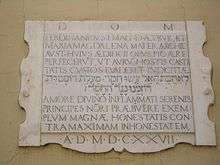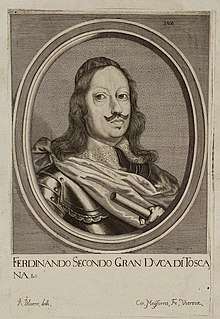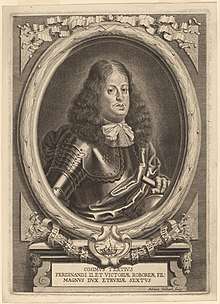Ferdinando II de' Medici, Grand Duke of Tuscany
Ferdinando II de' Medici (14 July 1610 – 23 May 1670) was grand duke of Tuscany from 1621 to 1670. He was the eldest son of Cosimo II de' Medici and Maria Maddalena of Austria. His 49-year rule was punctuated by the beginning of Tuscany's long economic decline.[1] He married Vittoria della Rovere, a first cousin, with whom he had two children who reached adulthood: Cosimo III de' Medici, his eventual successor, and Francesco Maria de' Medici, Duke of Rovere and Montefeltro, a cardinal.
| Ferdinando II | |||||
|---|---|---|---|---|---|
 Ferdinando II de' Medici in Coronation Robes (circle of Justus Sustermans). | |||||
| Grand Duke of Tuscany | |||||
| Reign | 28 February 1621 – 23 May 1670 | ||||
| Predecessor | Cosimo II | ||||
| Successor | Cosimo III | ||||
| Born | 14 July 1610 Pitti Palace, Florence | ||||
| Died | 23 May 1670 (aged 59) Pitti Palace, Florence | ||||
| Spouse | Vittoria della Rovere | ||||
| Issue Detail | Cosimo III, Grand Duke of Tuscany Francesco Maria, Duke of Rovere | ||||
| |||||
| House | House of Medici | ||||
| Father | Cosimo II de' Medici | ||||
| Mother | Maria Maddalena of Austria | ||||
| Religion | Roman Catholicism | ||||
Biography
Ferdinando was only 10 years of age when his father Cosimo II died. Because he had not yet reached maturity, his mother Maria Maddalena and paternal grandmother, Christina of Lorraine, acted as joint regents.[2] In his seventeenth year, Ferdinando embarked on a tour of Europe. One year later, his regency ended and his personal rule began.[3] The dowager Grand Duchess Christina was the power behind the throne until her death in 1636.
Ferdinand, like Christina before him, was a patron, ally, and friend of Galileo Galilei. Galileo dedicated his Dialogue Concerning the Two Chief World Systems to him. This work led to Galileo's second set of hearings before the Inquisition. Ferdinand attempted to keep the concerns of the Holy See from leading to a full-fledged hearing and kept Galileo in Florence until December 1632, when the Roman Inquisitors finally threatened to bring Galileo to Rome in chains if he would not come voluntarily. In June 1633, the Roman Inquisition convicted the astronomer for "vehement suspicion of heresy" and sentenced him to imprisonment for life. After this was commuted to house arrest, the devoutly Catholic Ferdinand welcomed Galileo back to Florence.

The first calamity of Ferdinando’s reign was an outbreak of the plague that swept through Florence in 1630 and took 10% of the population with it.[4] Unlike the Tuscan nobility, Ferdinando and his brothers stayed in the city to try to ameliorate the general suffering.[5] His mother and grandmother arranged a marriage with Vittoria della Rovere, a granddaughter of the last Duke of Urbino, in 1633. Together they had two children: Cosimo, in 1642, and Francesco Maria de' Medici, in 1660. The latter was the fruit of a brief reconciliation, as after the birth of Cosimo, the two became estranged; Vittoria caught Ferdinando in bed with a page, Count Bruto della Molera.[6]

Ferdinando was obsessed with new technology and had several hygrometers, barometers, thermometers and telescopes installed in the Palazzo Pitti.[7] In 1654, influenced by Galileo, he is reported to have invented the sealed-glass thermometer by sealing the glass tip of a tube filled to a certain height with colored alcohol. Small glass bubbles filled with air at varying pressures hovered trapped within the liquid, changing positions as the temperature rose or fell. Marked off with 360 divisions, like the gradations or "degrees" of a circle, this type of device was called a "spirit thermometer", because it was filled with "spirit of wine" (distilled alcohol), or a "Florentine thermometer" (Florence being the capital of Tuscany).[8] In 1657, Leopoldo de' Medici, the grand duke’s youngest brother, established the Accademia del Cimento. It was set up to attract scientists from all over Tuscany to Florence for mutual study.[9]
Tuscany participated in the Wars of Castro (the last time Medicean Tuscany was involved in a military conflict) and inflicted a defeat on the forces of Pope Urban VIII in 1643.[10] The treasury was so empty that when the Castro mercenaries were paid for the state could no longer afford to pay interest on government bonds. The interest rate was lowered by 0.75%.[11] The economy became so decrepit that barter trade became prevalent in rural market places.[10]
Ferdinando died on 23 May 1670 of apoplexy and dropsy. He was interred in the Basilica of San Lorenzo, the Medicis' necropolis.[12] At the time of his death, the population of the grand duchy was 730,594 souls; the streets were lined with grass and the buildings on the verge of collapse in Pisa.[13]
Titles and styles
| Styles of Ferdinando II de' Medici, Grand Duke of Tuscany | |
|---|---|
 | |
| Reference style | His Highness |
| Spoken style | Your Highness |
- 14 July 1610 – 28 February 1621: His Highness The Grand Prince of Tuscany
- 28 February 1621 – 23 May 1670: His Highness The Grand Duke of Tuscany
Issue
From his unhappy marriage to Vittoria Della Rovere, Ferdinand II had four sons, of which only two reached adulthood:
- Cosimo, Grand-Prince of Toscany (19 December 1639 – 21 December 1639)
 Cosimo III, second son of Ferdinando II, engraving by Adriaen Haelwegh
Cosimo III, second son of Ferdinando II, engraving by Adriaen Haelwegh - A nameless son who died in infancy (1640)
- Cosimo III, (14 August 1642 – 31 October 1723), Grand Duke of Toscany following his father's death, married to Marguerite Louise d'Orléans, with issue
- Francesco Maria (12 November 1660 – 3 February 1711), Duke of Rovere and Montefeltro, married to Eleonora Luisa Gonzaga, without issue
Ancestry
| Ancestors of Ferdinando II de' Medici, Grand Duke of Tuscany | ||||||||||||||||||||||||||||||||||||||||||||||||||||||||||||||||||||||||||||||||||||||||||||||||||||||||||||||||||||||||||||||||||||||||||||||||||||||||||||||||||||||||||||||||||||||||||||||||||||||||||||||||||||||||||||||||||||||||||||||||||||||||||||||||||||||||||||||||||||||||||||||||||||||||||||||||||||||||||||||||||||||||||||||||||||||||||||||||||||||||||||||||||||||||||||||||||||||||||||||||||||||||||||||||||||||||||||||||||||||||||||||||||||||||||||||||||||||||||||||||||||||||||||||||||||||||||||||||||||||||||||||||||||||||||||||||||||||||||||||||||||||||||||||||||||||||||||||||
|---|---|---|---|---|---|---|---|---|---|---|---|---|---|---|---|---|---|---|---|---|---|---|---|---|---|---|---|---|---|---|---|---|---|---|---|---|---|---|---|---|---|---|---|---|---|---|---|---|---|---|---|---|---|---|---|---|---|---|---|---|---|---|---|---|---|---|---|---|---|---|---|---|---|---|---|---|---|---|---|---|---|---|---|---|---|---|---|---|---|---|---|---|---|---|---|---|---|---|---|---|---|---|---|---|---|---|---|---|---|---|---|---|---|---|---|---|---|---|---|---|---|---|---|---|---|---|---|---|---|---|---|---|---|---|---|---|---|---|---|---|---|---|---|---|---|---|---|---|---|---|---|---|---|---|---|---|---|---|---|---|---|---|---|---|---|---|---|---|---|---|---|---|---|---|---|---|---|---|---|---|---|---|---|---|---|---|---|---|---|---|---|---|---|---|---|---|---|---|---|---|---|---|---|---|---|---|---|---|---|---|---|---|---|---|---|---|---|---|---|---|---|---|---|---|---|---|---|---|---|---|---|---|---|---|---|---|---|---|---|---|---|---|---|---|---|---|---|---|---|---|---|---|---|---|---|---|---|---|---|---|---|---|---|---|---|---|---|---|---|---|---|---|---|---|---|---|---|---|---|---|---|---|---|---|---|---|---|---|---|---|---|---|---|---|---|---|---|---|---|---|---|---|---|---|---|---|---|---|---|---|---|---|---|---|---|---|---|---|---|---|---|---|---|---|---|---|---|---|---|---|---|---|---|---|---|---|---|---|---|---|---|---|---|---|---|---|---|---|---|---|---|---|---|---|---|---|---|---|---|---|---|---|---|---|---|---|---|---|---|---|---|---|---|---|---|---|---|---|---|---|---|---|---|---|---|---|---|---|---|---|---|---|---|---|---|---|---|---|---|---|---|---|---|---|---|---|---|---|---|---|---|---|---|---|---|---|---|---|---|---|---|---|---|---|---|---|---|---|---|---|---|---|---|---|---|---|---|---|---|---|---|---|---|---|---|---|---|---|---|---|---|---|---|---|---|---|---|---|---|---|---|---|---|---|---|---|---|---|---|---|---|---|---|---|---|---|---|---|---|---|---|---|---|---|---|---|---|---|---|---|---|---|---|---|---|---|---|---|---|---|---|---|---|---|---|---|---|---|---|---|---|---|---|---|---|---|---|---|---|---|---|---|---|---|---|---|---|---|---|---|---|---|---|---|---|---|---|---|---|---|---|---|---|---|---|---|---|---|---|---|---|---|---|---|---|---|---|---|---|---|---|---|---|---|---|---|---|---|---|---|---|---|---|---|---|---|---|---|---|---|---|---|---|---|---|---|---|---|---|---|---|---|
| ||||||||||||||||||||||||||||||||||||||||||||||||||||||||||||||||||||||||||||||||||||||||||||||||||||||||||||||||||||||||||||||||||||||||||||||||||||||||||||||||||||||||||||||||||||||||||||||||||||||||||||||||||||||||||||||||||||||||||||||||||||||||||||||||||||||||||||||||||||||||||||||||||||||||||||||||||||||||||||||||||||||||||||||||||||||||||||||||||||||||||||||||||||||||||||||||||||||||||||||||||||||||||||||||||||||||||||||||||||||||||||||||||||||||||||||||||||||||||||||||||||||||||||||||||||||||||||||||||||||||||||||||||||||||||||||||||||||||||||||||||||||||||||||||||||||||||||||||
Citations
- Strathern, p 381
- Hale, p 178
- Strathern, p 375
- Hale, p 179
- Acton, p 29
- Acton, p 30
- Acton, p 27
- Bolton, Henry C. (1900). Evolution of the Thermometer, 1592-1743 (Ferdinand, pg. 33). Chemical Publishing Co.
- Acton, p 38
- Hale, p 180
- Hale, p 181
- Acton, p 108
- Acton, p 112
See also
References
- Acton, Harold: The Last Medici, Macmillan, London, 1980, ISBN 0-333-29315-0
- Strathern, Paul: The Medici: Godfathers of the Renaissance, Vintage books, London, 2003, ISBN 978-0-09-952297-3
- Hale, J.R.: Florence and the Medici, Orion books, London, 1977, ISBN 1-84212-456-0
Further reading
- Liedtke, Walter A. (1984). Flemish paintings in the Metropolitan Museum of Art. New York: The Metropolitan Museum of Art. ISBN 0870993569. (see index, v.1, for information about Ferdinando as a patron of the arts)
External links
![]()
Ferdinando II de' Medici, Grand Duke of Tuscany Born: July 14 1610 Died: May 23 1670 | ||
| Regnal titles | ||
|---|---|---|
| Preceded by Cosimo II de' Medici |
Grand Duke of Tuscany 1621–1670 |
Succeeded by Cosimo III de' Medici |
| Italian royalty | ||
| Preceded by Cosimo di Ferdinando de' Medici |
Hereditary Prince of Tuscany 1610–1621 |
Succeeded by Cosimo di Ferdinando de' Medici |
